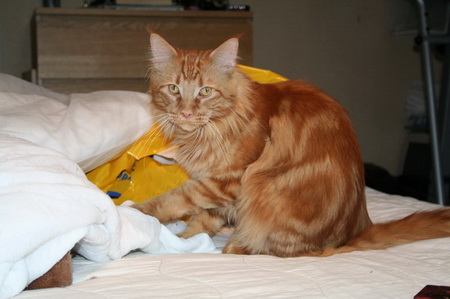- Details
- Hits: 2885
It's a lot too much and hard to compare all it would become messy and hard to read so I choose to only compare classic tabby to the shaded, shell and smoke, as well as black tabby to golden tabby, golden shaded, and golden shell. Please do learn about all the other patterns as well, knowledge is good. I'm not a member of FIFe, however when it comes to describing the colors, there is no standard who do describe the colors in detail as much as the FIFe standard, that's why I use this one as a tool for us all.
I tried to do it as clearly as possible, I will continue to check this to make sure I have not missed anything.
Silver variations
Golden variations
|
|
Silver Classic tabby | Silver Shaded | Silver Shell | Smoke |
| Coat color |
Hairs show various numbers of silver-white bands, separated from each other by the corresponding color (ticking). The hairs may be uniform all over the coat or separated from each other by solid-colored hairs. Forming the different patterns.
|
Hairs are tipped with the appropriate color. Tipping as even as possible. Tipping shading down from the back to the flanks and lighter on the front of the legs. The coat on the head, ears, back, flanks, and upper side of the tail must be tipped with color. |
Hairs are tipped with the appropriate color. Tipping as even as possible. Tipping shading down from the back to the flanks and lighter on the front of the legs. The coat on the head, ears, back, flanks, and upper side of the tail must be tipped with color. |
Hairs are tipped with the appropriate color, whit a narrow silver-white band at the roots, which can be seen ONLY when parting the hair. |
| Undercoat |
Pure pale silver |
Undercoat pure white | Undercoat pure white | Undercoat silver-white |
| Description |
The appropriate base color is a "dark" and clearly defined pattern with good contrast without ticked hairs (brindling). Shoulder markings are in the shape of a butterfly with both upper and lower wings distinctly defined. The back markings consist of a vertical line On each flank, there are large blotches in the color of the ground color encircled by one or more unbroken "darker" lines. Markings should be the same on each side. |
Tipping about 1/3 of the complete hair length. Tipping evenly distributed to give the characteristic sparkling silver appearance. |
Tipping about 1/8 of the entire hair length. Tipping evenly distributed to give the |
In stillness, the cat appears to be solid colored, but in motion, the silver-white undercoat is clearly visible. |
| Head |
Whiskerpads marked (spotted). Eyes are first surrounded by the darker color of the pattern, then surrounded by the lightest color of the pattern. Marking in the shape of an "M" on the forehead, an unbroken line runs back from the outer corner of the eye, 2 or 3 spirals on the cheeks, thumbprints on the ears, and 2 unbroken necklaces on the chest. |
Eyes and nose leather outlined with the color of the tipping, an even, distinct nose/eye rim is preferred. | Eyes and nose leather outlined with the color of the tipping, an even, distinct nose/eye rim is preferred. | The cats are silvery around the eyes and have silvery frown markings. Ruff and ear tufts are silvery white. |
| Legs |
The legs are evenly banded. The back of the feet is colored in the "dark" color. |
Broken rings on the legs are permitted. |
||
| Belly | A double row of "dark" spots (buttons) appears on the chest and the belly. | No spots on the chest or belly | No spots on the chest or belly | Undercoat silver-white. In repose, the cat appears to be solid colored, but in motion, the silver-white undercoat is clearly visible. |
| Remarks | White/light color is tolerated besides the nostrils, above the lips, on the chin as long as it does not extend down to the chest. Cats with white/lighter-colored chin are preferred |
In general, a shaded cat appears to be much darker than a shell. Shaded is considered a tabby pattern. |
In general, a shell cat appears to be Shell is considered a tabby pattern. |
A smoke without ghost markings is preferred. A smoke, is a cat of contrast Kittens often have ghost markings, which usually disappear when the kitten develops. |
| Faults |
Unbroken rings on the legs Spots on the chest or belly Uneven tipping Brown or yellowish tinge in the coat |
Unbroken rings on the legs Any color extending up to the joint of the hind legs. Spots on the chest or belly Uneven tipping Brown or yellowish tinge in the coat |
|
|
Black Classic tabby | Golden tabby | Golden Shaded | Golden Shell |
| Coat color |
Hair shows various numbers of yellowish bands separated from each other by the corresponding color (ticking). These hairs may be uniform all over the coat, or separated from each other by solid-colored hairs forming different patterns. The appropriate base color is a "dark" and clearly defined pattern with good contrast without ticked hairs (brindling). 2 unbroken necklaces on the chest. |
Patterns as described for 22/23/24/25 A Golden Tabby is a tabby cat where the yellowish bands in the hair are somewhat wider. This gives in general a lighter expression of color. Clear and visible pattern, and as described in the corresponding tabby pattern.
|
Hairs are tipped with the appropriate color. Tipping as even as possible. Tipping shading down from the back to the flanks and lighter on the front of the legs. The coat on the head, ears, back, flanks, and upper side of the tail must be tipped with color. The ground color is more intensive on the face and back, with a lighter shade on the chin, the ear tufts, down the flanks, on the belly, and the underside of the tail. Color and distribution of tipping as for the Hairs are tipped with the appropriate color. Tipping as even as possible. The coat on the head, ears, back, flanks, and upper side of the tail must be tipped with color. |
Hairs are tipped with the appropriate color. Tipping as even as possible. Tipping shading down from the back to the flanks and lighter on the front of the legs. The coat on the head, ears, back, flanks, and upper side of the tail must be tipped with color. The ground color is more intensive on the face and back, with a lighter shade on the chin, the ear tufts, down the flanks, on the belly, and the underside of the tail.
Color and distribution of tipping as for the Hairs are tipped with the appropriate color. Tipping as even as possible. The coat on the head, ears, back, flanks, and upper side of the tail must be tipped with color. |
| Undercoat |
Ground color: Warm, brilliant coppery brown down to the roots, black ticked. Pattern/Ticking: Clear dense black. |
Very warm, from dark yellow to apricot | Very warm, from dark yellow to apricot | Very Warm, from dark yellow to apricot |
| Description |
The appropriate base color is a "dark" and clearly defined pattern with good contrast without ticked hairs (brindling). Shoulder markings are in the shape of a butterfly with both upper and lower wings distinctly defined.
On each flank, there are large blotches in the color of the ground color encircled by one or more unbroken "darker" lines. Markings should be the same on each side. |
|
Tipping about 1/3 of the complete hair length. Tipping is evenly distributed. The ground color is more intensive on the face and back, with a lighter shade on the chin, the ear tufts, down the flanks, on the belly, and the underside of the tail. Color and distribution of tipping as for the corresponding silver shaded/shell varieties(*s 11/12). |
Tipping about 1/8 of the entire hair length. Tipping is evenly distributed. |
| Head |
Whiskerpads marked (spotted). Eyes are first surrounded by the darker color of the pattern, then surrounded by the lightest color of the pattern. The edges of the ears are colored by the lighter color of the pattern. Marking in the shape of an "M" on the forehead, an unbroken line runs back from the outer corner of the eye, 2 or 3 spirals on the cheeks, thumbprints on the ears, and 2 unbroken necklaces on the chest. |
Eyes and nose leather outlined with the color of the tipping, an even, distinct nose/eye rim is preferred.
|
Eye rims are the same color as the tipping Whisker pads, chin, and chest may be light to deep cream. |
Eye rims are the same color as the tipping Whisker pads, chin, and chest may be light to deep cream. |
| Legs |
The legs are evenly banded The back of the feet is colored in the "dark" color. |
|
Broken rings on the legs | Broken rings on the legs |
| Belly | A double row of "dark" spots (buttons) appears on the chest and the belly. | The belly without tipping | The belly without tipping | |
| Remarks |
White/light color is tolerated beside the nostrils, above the lips, and on the chin, as long as it does not extend down to the chest. Cats with white/lighter-colored chin are preferred. |
White/light color is tolerated besides the nostrils, above the lips, and on the chin as long as it does not extend down to the chest. Cats without white/lighter-colored chin are preferred. The dark color of the nose rim may extend over the whole nose leather and thus be the same as the corresponding solid color |
White/light color is tolerated beside the nostrils, above the lips, and on the chin as long as it does not extend down to the chest. Cats without white/lighter-colored chin are In general, a shaded cat appears to be much darker than a shell. Shaded is considered a tabby pattern A Golden shaded without tabby markings and bars and with a warm coat color is |
White/light color is tolerated beside the nostrils, above the lips, and on the chin as long as it does not extend down to the chest. Cats without white/lighter-colored chin are preferred. In general, a shaded cat appears to be much darker than a shell. Shaded is considered a tabby pattern A Golden shaded without tabby markings and bars and with a warm coat color is |
| Faults |
Ticked hairs (brindling) in the dark parts of the pattern Lack of contrast |
Coat too pale or too grey in tone Grey undercoat Unbroken rings on the legs Spots on the chest or belly Uneven tipping Solid colored hairs All tabby markings |
Coat too pale or too grey in tone Grey undercoat Unbroken rings on the legs Spots on the chest or belly Uneven tipping Solid colored hairs All tabby markings |
- Details
- Hits: 2031
This is a trait that is often misunderstood, much because of the daily names given to this trait.
The silver trait, genetically called the inhibitor trait, is a trait that suppresses the color at the base of the hair so which makes the bottom of the hair pure white.
Then we have the purely linguistic that can make it hard for all who are new to this, a cat with this gene is called different depending on whether it is agouti or non-agouti.
Agouti = Black silver tabby, red silver mackerel tabby, blue silver ticked tabby, etc….
Non-Agouti = Black smoke, Red smoke, Blue smoke, etc ...
In this article, I will talk about the trait itself and will just call it silver.
The silver trait is designated I (for the inhibitor gene).
|
ii |
Non-silver |
The cat has no silver gene and will not show silver nor pass down any silver. |
|
Ii |
Heterozygous silver |
The cat has one copy of the gene and will be able to give either silver or non-silver to its offspring. |
|
II |
Homozygous silver |
No matter what the cat is mated with, all offspring will be silver if the parent is homozygous since it will always inherit one copy of the gene (I). |
Since silver is dominant, the rule is what you see is what you get, if you see silver the cat is silver, and if you do not see silver there is no inhibitor gene present. But most rules got exceptions, I just want to mention it very briefly and it’s not something we should go deeper into, but it has been proven over the years that the silver sometimes hides, in non-agouti blue cats. The cat appears to be non-silver, but it got the inhibitor gene and will give it to its offspring. So there are cats with "invisible" silver, although this is relatively uncommon, and as far as I know happens ONLY with blue non-agouti cats for some reason.
What makes it confusing for those new to colors in cats are that this trait is given different names depending on if the cat is an agouti (with pattern) or a non-agouti (without pattern).
Let's take a black cat as an example, let's say you got a black cat and you add the silver trait, you will then get a "Black smoke", if you instead got a Black tabby and add the same trait it will be called a "Black silver tabby", it's the same trait it will be inherited the same way express the same way, just two different names for the same trait. We sometimes hear people say they got a black smoke tabby, this shows how confusing this is for new breeders and owners.
For some reason shaded is also a trait that's been misunderstood and thought to be connected with the silver trait which is wrong, shaded is one name for the Wideband trait which can express itself on non-silver as well as on silver cats and has actually nothing to do with the inhibitor gene itself.
But this will be brought up more closely in another article.
Let's do a test mating, one can easily see that two non-silver will never ever be able to get any kittens that are silver, however, two heterozygous silver will be able to get kittens that are non-silver.
As can be seen in the table below, where both mom and dad are non-silver, the kids will also be non-silver. Thus, as seen here, there is no I, only i.
|
Male i |
Male i |
|
|
Female i |
ii |
ii |
|
Female i |
ii |
ii |
If we take another example then we will see another scenario here, both mother and father are here Silver but both are heterozygous and got 1 set of the silver trait.
In this example, 50% will be silver but carriers of non-silver. 25% will be homozygous silver and 25% will be non-silver.
|
Male I |
Male i |
|
|
Female I |
II |
Ii |
|
Female i |
Ii |
ii |
If we take another last example let the female be homozygous silver, and then we will see below that all offspring become silver. 50% will be heterozygous and 50% homozygous.
|
Male I |
Male i |
|
|
Female I |
II |
Ii |
|
Female I |
II |
Ii |
There is not much more to say about silver genetics when it comes to silver itself. However, silver can be tricky and can have a wide range of expressions, everything from very vague silver to cats with razor-sharp contrasts. And please remember there is a big difference between what you might get in theory and what you really get. Even if we expect 50/50 it can very well be zero or 100% or anything in between.
I will not bring up all the different patterns and colors, I will just use black as an example.
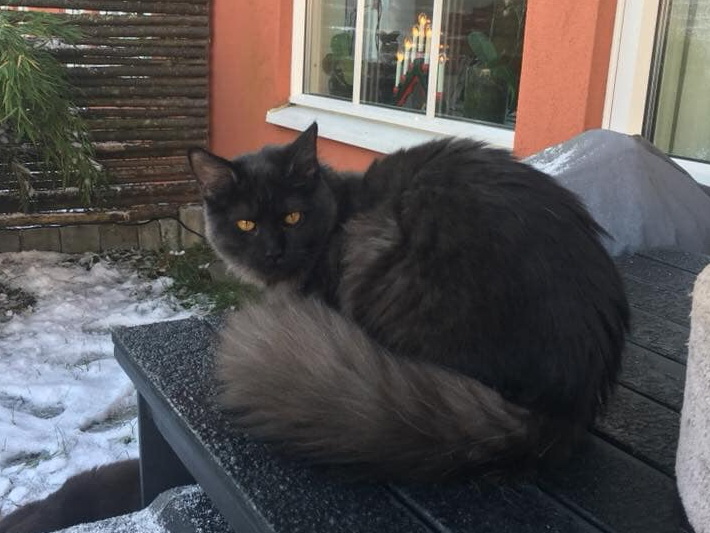 |
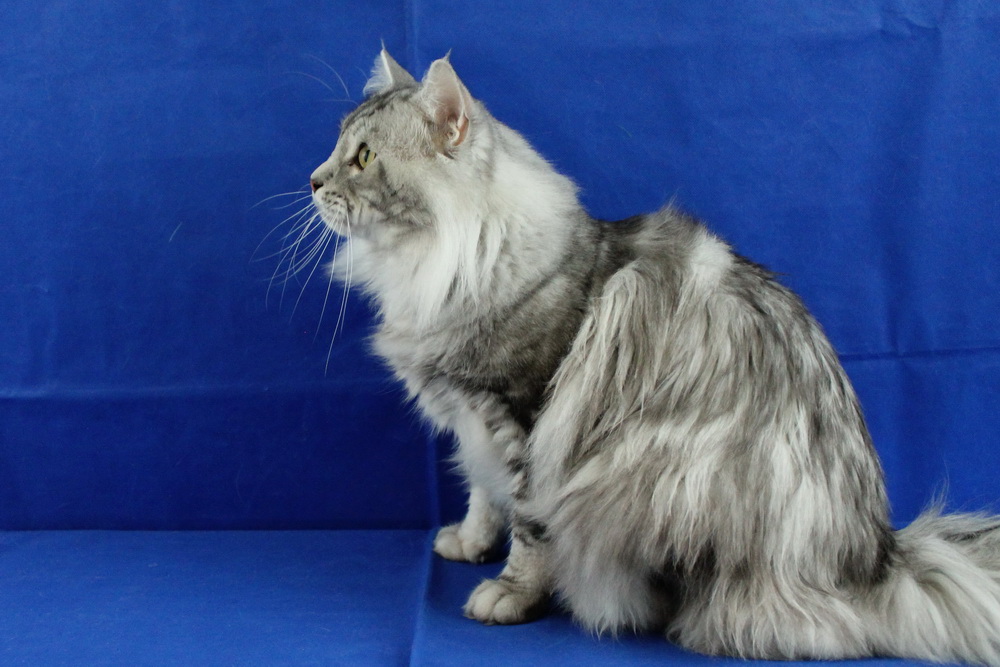 |
| This is a very good example of a Blacksmoke! A good black smoke should appear black when looking at it, it's first when the fur moves you would see the very pure bright white base of the coat. A Blacksmoke should have 50% white. |
A Blacksilvertabby on the other hand got banded hair, they should also have 50% silver. A silver tabby with more white at the base might be wideband, not enough to be shaded, but they might have the wideband trait. However, it might also be just polygenes. |
Written by: Malin Sundqvist
- Details
- Hits: 2630
Pattern
Ok then, let's talk about all these patterns. We know that the base colors are black or red. We can add on the dilution trait to bleach these to blue or cream and we have the agouti trait that determines whether the cat's pattern should be displayed or hidden. (Remember here all cats have a pattern even if we do not always see it).
The patterns we have on Maine Coon are:
Classic tabby, Mackerel tabby, Spotted tabby or Ticked tabby.
|
Classic |
mcmc |
Recessive (double genes are required for the pattern to be displayed). |
|
|
Mackerel |
McMc |
Dominant |
Homozygous Mackerel |
|
Mackerel |
Mcmc |
Dominant |
Heterozygous Mackerel, carries Classic |
|
Spotted |
Sp |
Dominant |
The gene breaks up the basic pattern to dots. |
| Spotted | Sp | The gene breaks up the basic pattern to dots | |
|
Tickad |
T |
Dominate over all the other patterns but are located in a separate locus. This means that a ticked cat can also carry another pattern. |
Ticked |
|
Tickad |
t |
Not ticked |
Here it will be a bit difficult when we begin to think of inheritance. Patterns are inherited as everything else in pairs, which means that a mackerel tabby can have one trait for mackerel tabby and one for classic tabby, which means that two mackerel tabby, if both are carrying classic tabby, actually can get offsprings who are classic tabby if the mc gene is inherited from both parents. Two classic tabby, on the other hand, can never ever get anything but classic tabby.
In the case of spotted tabby, there are two variants, one who believes be the one who gives us the cats that are mackerel tabby on one side and spotted tabby on the other. This is thought to be the ones who have mackerel tabby as a base pattern, while those who are very clearly spotted tabbies are those who have classic tabby as a basic pattern. How good the dots are, have nothing to do with whether the cat is heterozygous spotted or homozygous spotted.
The ticked tabby can be ticked in two different ways, either with several short breaks on the hair or with a few longer "on and off" (the hair will not become multi-banded ticked). Abessinier and Somali are homozygous ticked and have genotype TT while most other breeds with ticked cats have genotype Tt, heterozygous ticked, of course, we can by mate ticked with ticked also get homozygotes ticked on other breeds with ticked such as our Maine coon.
Below is a table where Cat 1 is heterozygous ticked but is also a carrier of both mackerel and classic tabby. Cat 2 is a mackerel but also a carrier of classic tabby.
|
Cat 1→ Cat 2↓ |
McT |
Mct |
mcT |
mct |
|
Mct |
McMc Tt |
McMc tt |
Mcmc Tt |
Mcmc tt |
|
Mct |
McMc Tt |
McMc tt |
Mcmc Tt |
Mcmc tt |
|
mct |
Mcmc Tt |
Mcmc tt |
mcmc Tt |
mcmc tt |
|
mct |
Mcmc Tt |
Mcmc tt |
mcmc Tt |
mcmc tt |
It's a bit tricky and you have to think a little, but hopefully, you understand the principle in any case, so in the example above it will be.
If you see above, then we see that 50% of the offspring will be Ticked tabby.
About 37.5% will be Mackerel tabby and 12.5% will be Classic tabby.
Some examples of patterns and genetic combinations:
McMc Spsp tt - The cat is homozygous mackerel with the spotted gene that breaks up the pattern in spots.
Mcmc Spsp tt - The cat is heterozygous mackerel with the spotted gene that breaks up the pattern in spots.
McMc spsp tt - The cat is homozygous mackerel without the spotted gene, therefore Mackerel Tabby.
Mcmc spsp tt - The cat is heterozygous mackerel without the spotted gene, therefore Mackerel Tabby.
mcmc Spsp tt - The cat is Classic tabby with the spotted gene that breaks up the pattern in spots.
mcmc spsp tt - The cat is Classic tabby without spotted genes, therefore only Classic Tabby.
In below example, everyone will be visibly ticked but carrying a few different other patterns.
McMc spsp Tt - Ticked cat that also carries homozygous Mackerel Tabby, no spotted
Mcmc spsp Tt - Ticked cat who also carries Mackerel Tabby, as well as carrying Classic tabby, no spotted.
mcmc spsp Tt - Ticked cat who also carries Classic tabby, no spotted.
At the moment, there are no DNA tests for the different pattern types, so we still have to live in uncertainty and learn as we may see what traits the cat will pass down to it's offsprings.
Skapad av: Malin Sundqvist
- Details
- Hits: 2225
Before we move on with the rest, I think it's important to have a very short basic review of dominant and recessive predispositions.
Dominant resp. Recessive
Traits are inherited in pairs and kittens will then inherit one of these from their mother and one of these from their father. Keep this in mind and go back to this article if it gets messy. I will try visually to show, trait by trait, so that it will be easier for you to see it in front of you, in all articles and for all traits. I will also state from the start whether it is a dominant or recessive predisposition.
Dominant traits:
Must be seen in one of the parents in order to be passed on and can therefore not be carried hidden.
For the dominant traits, this means that ONE set of the trait is enough for it to be visible.
However, remember that besides being a dominant trait, different traits can be dominant over each other, but you will learn about that later.
Recessive traits:
Can be carried hidden, in order for a recessive gene to be visible to the outside world, it is required that the cat has the trait in a double edition. So one edition is not enough for you to see the trait. A recessive trait can be carried hidden for all eternity before it suddenly reappears.
By: Malin Sundqvist
Dagdrivarn (www.dagdrivarn.se)
- Details
- Hits: 3650
Agouti
Let's move on to the next part, as I wrote at the in the first article, all cats have a pattern (sometimes two or more) but we will not go into those in this part, different patterns I will address later. In this part we only mention the Agouti gene, it is the trait that controls and tells whether the pattern that the cat carries should be shown or hidden.
Well, after a small side track, let us now sort out some basics and talk about Agouti, this is the trait that decides whether the pattern the cat carries should be shown or if the pattern should be hidden. Agouti / Non-agouti, or in everyday speech patterned / unpatterned or patterned / solid.
Agouti = A
Non-agouti = a
|
A/A Homozygous agouti |
All offsprings will show pattern. |
|
A/a Heterozygous agouti |
Offsprings might be agouti or non-agouti. Depending on whether the other part is A/a or a/a. |
|
a/a Homozygot för non-agouti |
If this cat is mated to another non-agouti all offsprings will also be non-agouti. |
Here one must consider that in some colors this trait is more or less transparent, this applies above all to red and cream. Silver and blue might also have some transparency, especially at certain ages.
This means that you will see the pattern on the cat even if it is non-agouti, ie not patterned.
I usually compare red with a glaze and black with a regular paint. If you paint a board with a glaze, you will always see the underlying pattern, but if you paint a board with paint, you will not see the pattern of the board through the paint. In the same way, red tends to act as a glaze and black as a paint.
This is a good example of a solid red cat (ie unpatterned red) with a very clear pattern.
Dagdrivarn Prince Mozez who was aa (non-agouti).
Here you might ask yourself, how do you determine if a cat is patterned or not in red or cream? There are ways to see this, if we only have red and cream, it is a bit easier, if you mix in silver, for example, it might be trickier and sometimes even really difficult. Many times, a DNA test is the only way to be completely sure whether the cat is agouti or non-agouti when we are dealing with these colors.
Below are two red cats, the one to the left is red tabby and to the right a solid red.
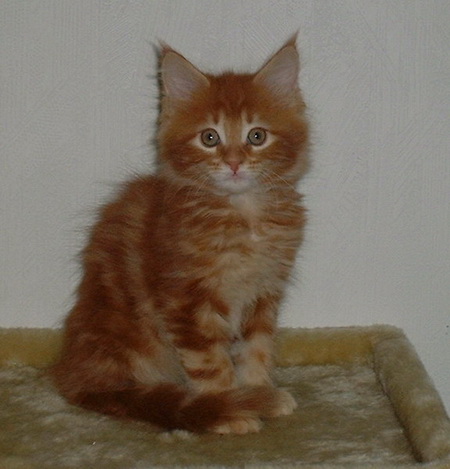 |
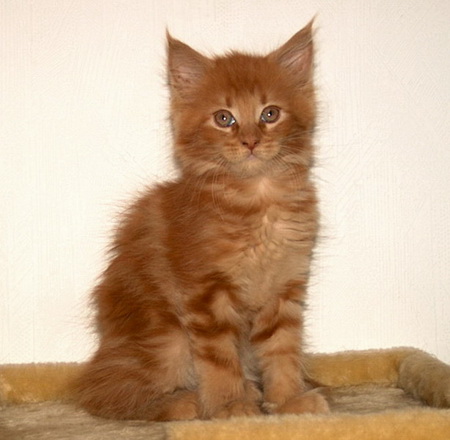 |
|
Agouti – You can clearly see here that the cat is light in the ears and edges of the ears, it has clear so-called. glasses (the light markings around the eyes) and are also light around the mouth. An agouti is also lighter under the abdomen and normaly has spots there, you might also want to look in the buttocks and will then see that the cat is light around the anus which then goes up in a string on the underside of the tail. |
Non-Agouti – Here you will instead see that the cat is dark in the ears and around the edges of the ears, the markings around the eyes are admittedly there, but are not white, just a little bit lighter than the base color, as well as the marking around the mouth and under the stomach. A non-agouti is evenly colored on the underside of the tail and around the anus. |
Below is an example of one agouti and one non-agouti
 |
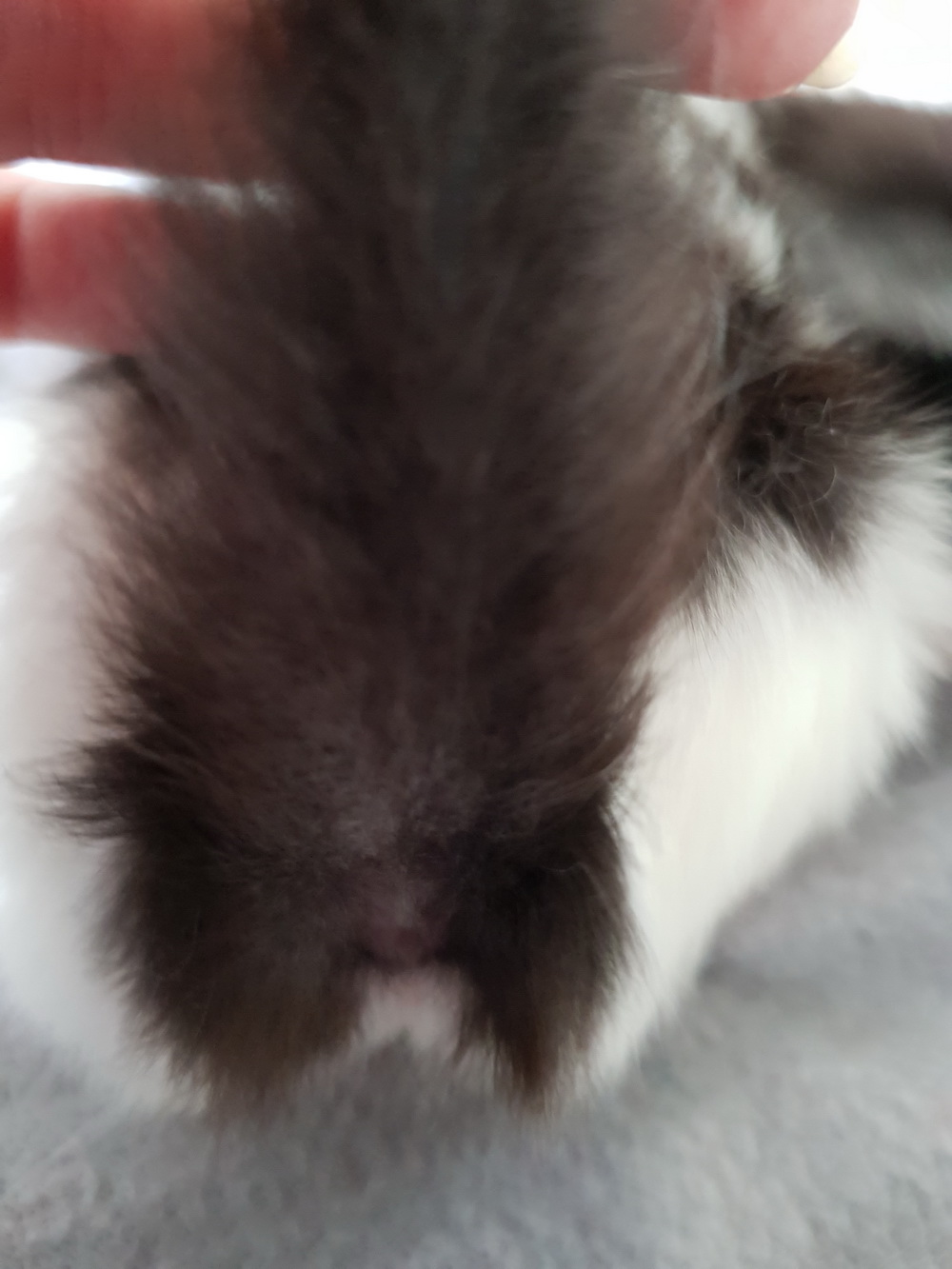 |
| As you can see in this picture the agouti kitten are bright under the tail, and got stripes |
In this picture you can see that the non-agouti kitten is dark around the anus, and also up the tail, no bright stripe. |
In conclusion, I will take some examples of inheritance of the trait.
In this example, we have a mother who is homozygous agouti and a father who is agouti but a carrier of non-agouti.
|
Dad |
Dad |
|
|
Mum |
AA |
Aa |
|
Mum |
AA |
Aa |
As we can see above, all kittens will be patterned (remember above, agouti is a dominant trait and it is only required that the cat has ONE copy of the gene for it to be shown). 50% homozygous and 50% heterozygous (ie patterned carriers of the trait non-agouti).
In this example, both mother and father are heterozygous, ie agouti but carriers of non-agouti.
|
Dad |
Dad |
|
|
Mum |
AA |
Aa |
|
Mum |
Aa |
aa |
Here the odds have changed a bit, 25% will be homozygous agouti, these will never be able to have an non-agouti offspring. 50% will be agouti but will carry the trait for non-agouti. And finally, 25% will be non-agouti.
In this example, we have an non-agouti mother and a father who is agouti but carries non-agouti.
|
Dad |
Dad |
|
|
Mum |
Aa |
aa |
|
Mum |
Aa |
aa |
As you can see above, we here got another distribution, 50% will be agouti but carriers of non-agouti, and 50% will be non-agouti.
Let's take one last example for it to be crystal clear. Both mom and dad are non-agouti.
|
Dad |
Dad |
|
|
Mum |
aa |
aa |
|
Mum |
aa |
aa |
In this last example, we see that all offspring will be non-agouti, there is no trait for the agouti to be carried on to the offsprings. This means that all offspring will be non-agouti, and this also means that two non-agouti can never ever get an agouti offspring.
By: Malin Sundqvist
Dagdrivarn (www.dagdrivarn.se)
Subcategories
goldeninvestigation
All investigation and picture pedigrees for the golden investigation will be here.

